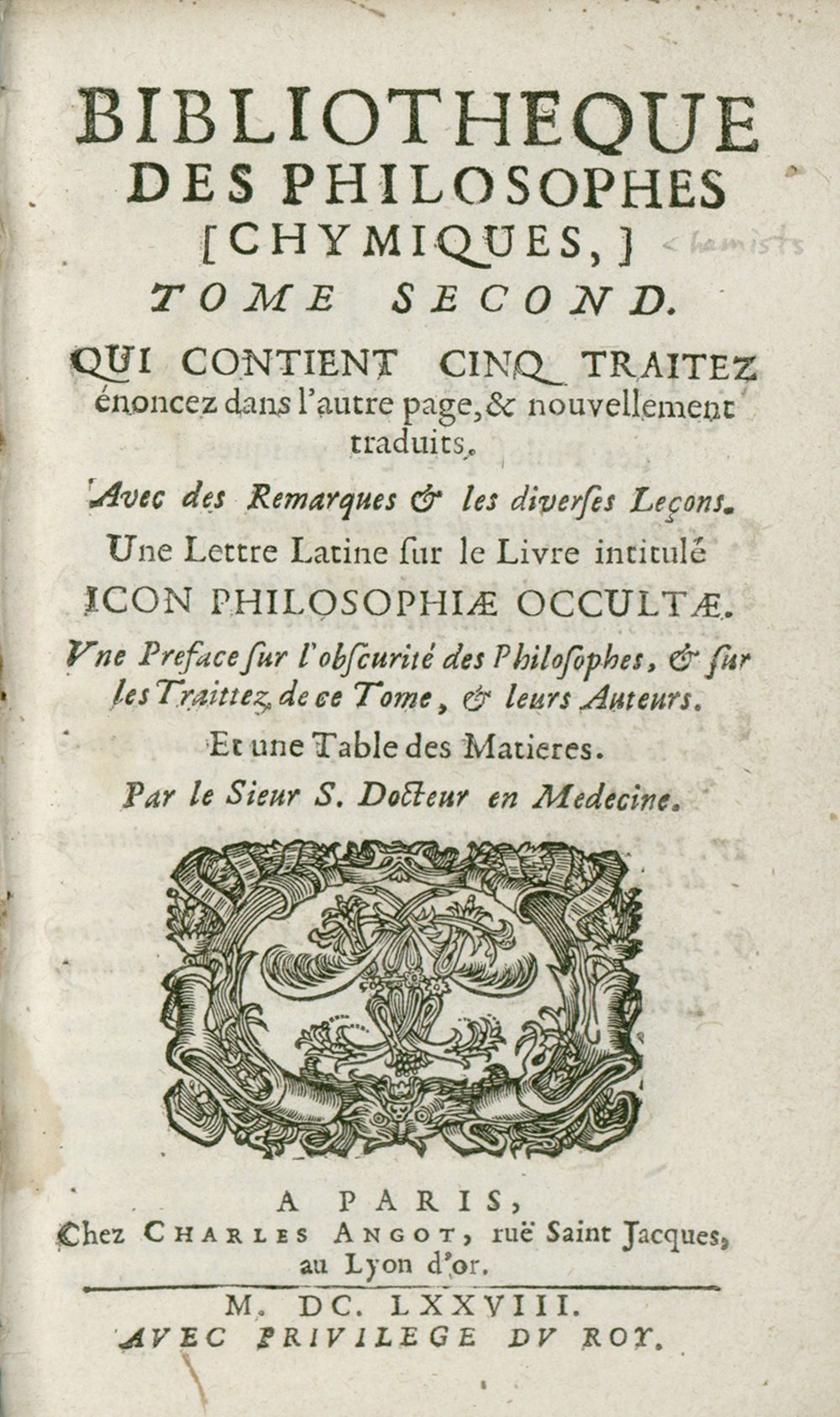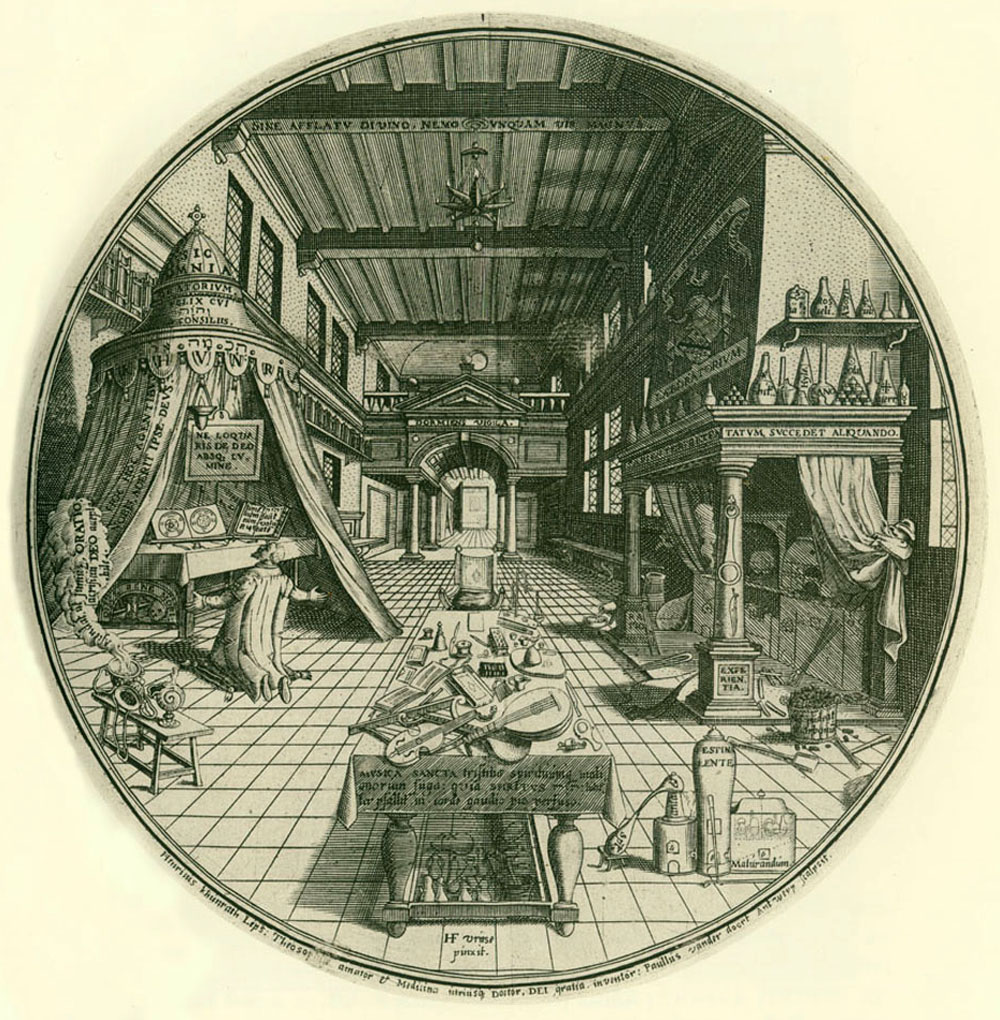Occult Science and the Philosophy of the Renaissance
 Geber [Jabir ibn Hayyan]. La Somme de la Perfection, ou L’Abregé du Magistere Parfait, in William Salmon, Bibliothèque des Philosophes (Chymiques), Tome Second. Paris: Charles Angot, 1678.
Geber [Jabir ibn Hayyan]. La Somme de la Perfection, ou L’Abregé du Magistere Parfait, in William Salmon, Bibliothèque des Philosophes (Chymiques), Tome Second. Paris: Charles Angot, 1678.
Rare QD25 .A2 B4
Many consider the Persian scientist and philosopher Geber (ca. 721 – ca. 815) to be the father of modern chemistry. He is credited with the invention of more than twenty types of basic chemical laboratory equipment that are still in use today, as well as with the discovery and description of many now-commonplace chemical substances and processes, including hydrochloric acid and distillation.
Geber was also one of history’s most famous alchemists, and his works are filled with references to what we would now call magic rather than science. In his The Book of Stones, for example, Geber includes instructions for creating living creatures such as scorpions, snakes, and even humans in a laboratory—creatures which their creator is supposed to be able to control. To Aristotelian physics, which was based on the five classical elements of earth, air, fire, water and ether, Geber added four new properties: hotness, coldness, dryness, and moistness. He then theorized that by rearranging the qualities of one metal, a different metal would result. This theory may have originated the search for a magic elixir—known in Europe as the Philosopher’s Stone—that would make this transformation possible.
In the Middle Ages, both in Europe and the Near East, alchemy was considered heretical. Religious authorities punished or put to death anyone who openly wrote on the subject. In his writings, therefore, Geber deliberately used mystical jargon that would have been difficult for anyone who had not been initiated into his teachings to understand. The incomprehensibility of his works on alchemy became so well known, in fact, that his name is thought to be the source of the English word “gibberish.”
 Robert Boyle. New Experiments Physico-Mechanical. Oxford: Thomas Robinson, 1662.
Robert Boyle. New Experiments Physico-Mechanical. Oxford: Thomas Robinson, 1662.
Rare QC161 .B79
The Anglo-Irish scientist and philosopher Robert Boyle (1627-1691) ranks with Isaac Newton and Galileo Galilei as one of the leaders of the Scientific Revolution of the seventeenth century. Many consider him the first modern chemist, and his groundbreaking treatise on the air-pump (displayed here) marked the beginning of a new age in scientific experimentation.
Few realize, however, that Boyle’s work was deeply rooted in alchemy. His famous dialogue The Sceptical Chymist (1661) has traditionally been viewed as an attack on quack doctors and alchemists. Yet in 2000, historian Lawrence Principe published a new book, The Aspiring Adept: Robert Boyle and His Alchemical Quest, in which he reconsiders Boyle’s views on alchemy.
Principe reveals that Boyle was instrumental in obtaining the repeal, in 1689, of the statute of King Henry IV against using alchemy to multiply gold and silver. He radically reinterprets The Sceptical Chymist to show that it actually does not criticize alchemists, as has been thought. He then gives evidence of Boyle’s interest in alchemy in his lost “Dialogue on the Transmutation and Melioration of Metals,” and shows how his research was disguised at first by his own codes and secrecy. According to Principe, Boyle believed that the goal of his quest, the Philosopher’s Stone, could not only transmute base metals into gold, but could also attract angels. Alchemy could thus act both as a source of knowledge and as a defense against the growing tide of atheism that tormented Boyle, a devout Christian who, as a director of the East India Company, spent a great deal of money promoting the spread of Christianity in Asia.
 An alchemist in his laboratory. Engraving from Heinrich Khunrath, Amphitheatrum Sapientiae Aeternae, 1609. Reproduced in Ian Macphail, Alchemy and the Occult. New Haven: Yale University Library, 1968.
An alchemist in his laboratory. Engraving from Heinrich Khunrath, Amphitheatrum Sapientiae Aeternae, 1609. Reproduced in Ian Macphail, Alchemy and the Occult. New Haven: Yale University Library, 1968.
Rare Z6880 .M3 vol. 1 Oversize
Arthur Edward Waite, a historian of alchemy, considers this a key image. Though the room is filled with chemical instruments, the alchemist’s back is turned to them while he kneels in devotion. For Waite, this suggests that alchemy’s true goal was not literally to turn base metals into gold, but rather to transform the mind and spirit of the alchemist himself into something purer through religious contemplation and the study of nature. The alchemist engaged in an internal quest for wisdom and truth, in much the same way as the knights of the Arthurian legend had done.
